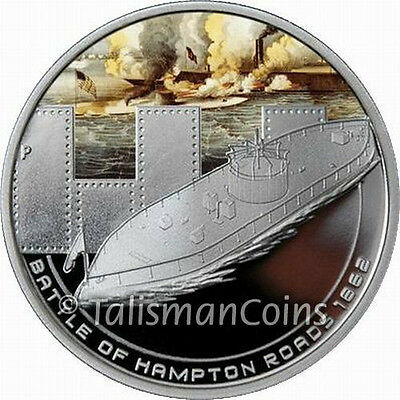-40%
Cook Islands 2010 Famous Naval Battles Hampton Roads Monitor Silver Prf OGP
$ 33.23
- Description
- Size Guide
Description
In Stock and Ready for Immediate Shipment!SOLD OUT at the Perth Mint!
Monitor
vs.
Merrimack
! The revolutionary Civil War navel battle, the first clash of ironclad warships, is immortalized on this full color, pure silver proof!
North versus South in the Duel of the Ironclads! Talisman Coins and the Perth Mint are extremely pleased to present the new
Famous Naval Battles Series
. Following on the heels of the tremendously well received
Famous Battles of History
program, the
Famous Naval Battles Series
offers pure silver dollars commemorating five important naval conflicts that have shaped the course of history. All are remembered for their landmark contributions to the annals of naval warfare. The third salvo (if you will) is the Battle of Hampton Roads, the indecisive first clash of ironclad warships during the American Civil War.
The Civil War
Monitor
and
Merrimack
charted a completely new course for the future of the warship. Before the Battle of Hampton Roads, the seas were dominated by wooden vessels, propelled by the wind, firing cannon through gunports. No more radical transformation has ever overtaken the world's navies, much less in a single day. After the historic duel of the ironclads on May 9, 1862, wood and sail were out; the new naval order involved steel ships cruising the world's oceans under the power of steam while firing rifled guns from turrets. Ironclads proved to be one of a number of the Civil War's modern technological innovations (including the machine gun, submarine, trench warfare, and aircraft) that would later surface in the First World War.
Duel of the Ironclads!
The Battle of Hampton Roads, often referred to as the Battle of the
Monitor
and
Merrimack
(or
Merrimac
), was the most famous, and arguably most important, naval battle of the American Civil War (from the standpoint of naval innovation and development). It was fought over two days, March 8-9, 1862, in Hampton Roads, a roadstead in Virginia where the Elizabeth and Nansemond Rivers meet the James River just before it enters Chesapeake Bay. The battle was a part of the effort of the Confederacy to break the Union blockade, which had cut off Virginia's largest cities, Norfolk and Richmond, from international trade.
The major significance of the battle is that it was the first meeting in combat of ironclad warships. The Confederate fleet consisted of the ironclad ram CSS
Virginia
(Merrimack) and several supporting vessels. On the first day of battle, they were opposed by several conventional, wooden-hulled ships of the Union Navy. On that day,
Virginia
was able to destroy two ships of the Federal flotilla and threaten a third,
USS Minnesota
, which had run aground. The action was halted by darkness and falling tide, so
Virginia
retired to take care of her few wounded (which included her captain, Flag Officer Franklin Buchanan) and repair her minimal battle damage.
Determined to complete the destruction of
Minnesota
, Catesby ap Roger Jones, acting as captain in Buchanan's absence, returned the ship to the fray the next morning, March 9. During the night, however, the ironclad
USS Monitor
had arrived and had taken a position to defend
Minnesota
. When
Virginia
approached,
Monitor
intercepted her. The two ironclads fought for about three hours, with neither being able to inflict significant damage on the other. The duel ended indecisively,
Virginia
returning to her home at the Gosport Navy Yard for repairs and strengthening, and
Monitor
to her station defending
Minnesota
. The ships did not fight again, and the blockade remained in place.
The battle received worldwide attention, and it had immediate effects on navies around the world. The preeminent naval powers, Great Britain and France, halted further construction of wooden-hulled ships, and others followed suit. A new type of warship was produced, the monitor, based on the principle of the original. The use of a small number of very heavy guns, mounted so that they could fire in all directions using the turret concept was first demonstrated by
Monitor
but soon became standard in warships of all types. Shipbuilders also incorporated rams into the designs of warship hulls for the rest of the century, and finally saw the reality of using steam power without masts or sails.
Rediscovery and Recovery of
USS Monitor
In 1973, the wreck of the ironclad
Monitor
was located on the floor of the Atlantic Ocean about 16 nautical miles southeast of Cape Hatteras, North Carolina. In 1998 the warship's propeller was raised to the surface. On July 16, 2001, divers from the Monitor National Marine Sanctuary and the US Navy brought to the surface the 30 ton steam engine. In August 2002, after 41 days of work, the revolutionary revolving gun turret was recovered by the U.S. National Oceanic and Atmospheric Administration (NOAA) and a team of U.S. Navy divers. Before removing the turret, divers discovered the remains of two trapped crewmen. The remains of these sailors, who died while on duty, are at the Joint POW-MIA Accounting Command (JPAC) at Hickam Air Force Base, Hawaii, awaiting positive identification. The site is now under the supervision of NOAA. Many artifacts from Monitor, including her turret, cannon, propeller, anchor, engine and some personal effects of the crew, have been conserved and are on display at the Mariners' Museum of Newport News, Virginia.
Once again, the Perth Mint has done history proud! The Battle of Hampton Roads Silver Proof depicts the height of the first fight between ironclads the world had ever seen, with the color vignette a true historical record of the battle, taken directly from a famous Currier & Ives print of 1862, entitled "Ironclads Engaged in Terrific Combat". The scene depicts
Monitor
and
Merrimack
trading broadsides at point blank range!
USS Monitor
is deftly engraved and struck in frosted cameo relief in the center of the coin, superimposed on a piece of
CSS Virginia
's armor, complete with gunports.
The Battle of Hampton Roads Pure Silver Proof is the third in the ongoing
Famous Naval Battles
series, to be released by the Perth Mint. The complete program comprises:
Salamis - 480 BC
- Ancient triremes
Trafalgar - 1805 AD
- Nelson and
Victory
vs. Napoleon
Hampton Roads - 1862 AD
- The duel between ironclads
USS
Monitor
and
CSS
Virginia
(
Merrimack
)
Jutland - 1916 AD
- Clash of the Dreadnoughts
Midway - 1942 AD
- Carrier vs. carrier
+
Five Coin Display Box
Please see the article further below for a short presentation on the Cook Islands.
Obverse
USS Monitor
, instantly recognizable with its low freeboard and round turret, is in the center of the coin, struck in frosted cameo relief.
Monitor
is superimposed on a piece of
CSS Virginia
's armor (complete with gunports). The battle itself is portrayed in color in a vignette taken from a period Currier & Ives print. The legend BATTLE OF HAMPTON ROADS 1862 defines the theme. The Perth Mint’s "P" mint mark can be found at the 9:30 position near the edge.
Reverse
Her Majesty, Queen Elizabeth II of England, in crowned profile facing right. This portrait, featuring Her Majesty wearing a tiara and pearl drop earrings, was executed by the sculptor Raphael Maklouf. The legend QUEEN ELIZABETH II, the date of issue and denomination also appear.
Packaging
The coin is encapsulated inside a handsome taupe leatherette, clamshell-style presentation case, lined with black velvet and satin, and protected by a full-color outer box. An individually-numbered certificate of authenticity is included.
Specifications
Country
Cook Islands
Mint
Perth Mint of Australia
Year of Issue
2010
Face Value
One Dollar
Weight
31.135 g
Diameter
409.60 mm
Gauge (Thickness)
4.00 mm
Mintage Limit
5,000
Finish
Proof with Color
Composition
.999 Fine (Pure) Silver
Edge
Reeded (milled, serrated)
Artist
Darryl Bellotti (obverse)
Raphael Maklouf (reverse)
Certificate
Individually Numbered
The Cook Islands
The Cook Islands are a self-governing parliamentary democracy in free association with New Zealand. The fifteen small islands in this South Pacific Ocean country have a total land area of 92.7 square miles (240 square kilometers), but the Cook Islands Exclusive Economic Zone (EEZ) covers 700,000 square miles (1.8 million square kilometers) of ocean. As of the 2006 census, the country has a total population of just under 20,000.
The main population centers are on the island of Rarotonga (14,153 as of 2006), where there is an international airport. There is also a much larger population of Cook Islanders in New Zealand, particularly the North Island. In the 2006 census, 58,008 New Zealanders identified themselves as being of ethnic Cook Island Maori descent.
With over 90,000 visitors traveling to the islands in 2006, tourism is the Cook Islands' number one industry, and the leading element of the economy, far ahead of offshore banking, pearls, marine and fruit exports.
Defense is the responsibility of New Zealand, in consultation with the Cook Islands and at its request. In recent times, the Cook Islands have adopted an increasingly independent foreign policy.
Copyright © 2020 Talisman World Coins and Medals. All Rights Reserved.











